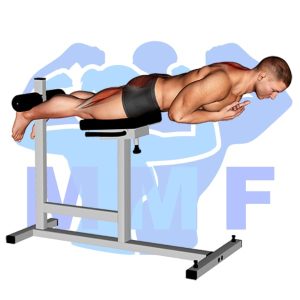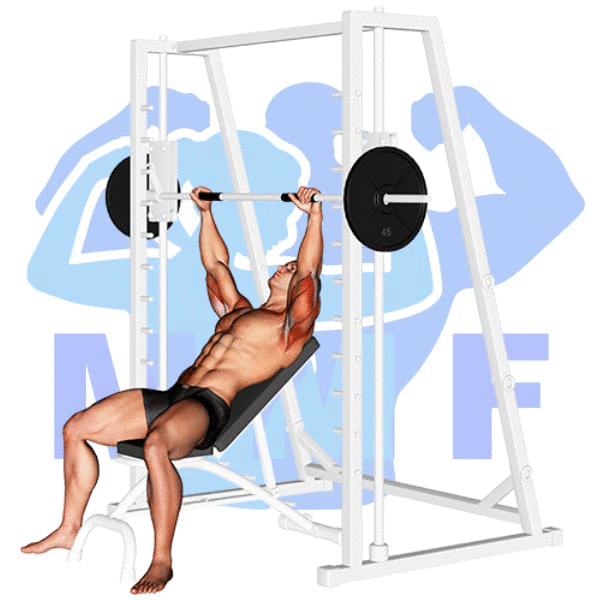Are you struggling to master the Smith Split Squat? You are not alone. Many people find it challenging to achieve proper form and balance in this exercise. It’s understandable, as the Smith Split Squat requires not only physical strength but also coordination and control. But don’t worry, this is a common problem, and with the right guidance, you will be able to perform this exercise with ease. In this blog post, I will provide you with step-by-step instructions on how to master this essential lower body exercise and improve your overall strength and fitness.
Smith Machine Split Squat Summary
- Primary Muscles: Quadriceps
- Secondary Muscles: Adductor Magnus, Gluteus Maximus, and Soleus
- Equipment: Smith Machine
- Mechanics Type: Compound
- Force: Push
- Utility: Auxiliary

Smith Machine Split Squat Instructions
- Stand facing away from the Smith Machine with the barbell resting across your back.
- Step one foot forward and bend both knees to lower into a split squat position.
- Ensure your front knee is directly above your ankle and your back knee is hovering just above the floor.
- Push through your front heel to stand back up and repeat for desired number of repetitions.
- Switch legs and repeat for desired number of repetitions.
Video Tutorial
Smith Machine Split Squat Muscles
Target (Agonist)
Synergists
- Adductor Magnus
- Gluteus Maximus
- Soleus
Dynamic Stabilizers
Stabilizers
- Tibialis Anterior
Antagonist Stabilizers

Benefits of Smith Machine Split Squat
The Smith Machine Split Squat is a great exercise for targeting the quadriceps. It is a unilateral exercise that can be performed with a variety of stances and foot placements, allowing for a greater range of motion and increased activation of the quadriceps. This exercise can also be performed without additional weight, making it an ideal exercise for those just starting out with strength training. Additionally, the Smith Machine Split Squat allows the lifter to safely perform the exercise while minimizing the risk of injury. As a result, this exercise is an effective way to target and strengthen the quadriceps in any strength training or fitness routine.
Tips for Performing Smith Machine Split Squat
When performing the Smith Machine Split Squat, it is important to ensure you are performing the exercise correctly in order to maximize its benefits. Below are a few tips on how to properly perform this exercise for maximum gains.
- Use a slow and controlled movement: It is important to focus on the eccentric, or lowering, phase of the split squat. This means controlling your descent into the squat position, rather than simply letting your body drop. Doing so will help engage more muscle fibers throughout the exercise and improve results.
- Make sure your front foot is far enough forward: To ensure that your glutes and quads are doing the work during the exercise, it is important to make sure your front foot is far enough forward so that your knee does not extend past your toes at the bottom of the squat.
- Keep your torso upright: Keeping your torso as upright as possible is important for engaging the correct muscles during the split squat. If your torso leans too far forward, it can take away from the effectiveness of the exercise and increase the risk of injury.
Benefits and Tips Video
Frequent Mistakes To Avoid
Before getting into the mistakes to avoid when performing the Smith Machine Split Squat, it’s important to note that this is a great exercise for anyone looking to build lower body strength and endurance. However, if done improperly, it can lead to a variety of injuries, so it’s important to take the time to familiarize yourself with proper form and technique. Now, let’s go over some of the most common mistakes people make while performing the Smith Machine Split Squat so you can stay safe and get the most out of your workout.
- Not maintaining proper form: It is important to keep your back straight and chest up throughout the movement, as well as ensure that you are in a proper split squat position with your feet shoulder width apart and your knees bent to 90 degrees.
- Using excessive weight: To maximize the effectiveness of the exercise and prevent injury, it is important to use a weight that is appropriate for your strength level. If the weight is too heavy, it can cause strain on the joints and put you at risk for injury.
- Not using a spotter: When performing the exercise with heavy weights, it is important to have a spotter present to help guide you and ensure that you are performing the exercise safely and correctly.
Find More Machine Exercises Here
Variations and Complementary Exercises
Performing the Smith Machine Split Squat is a great way to target the quads and glutes; however, it may not be the right exercise for everyone. Therefore, here are some variations, complementary, or alternative exercises that work similar muscles as the Smith Machine Split Squat.
Dumbbell Split Squat

Dumbbell Split Squat is a great alternative or complementary exercise to the Smith Machine Split Squat. It engages the same muscles as the Smith Machine Split Squat, such as the glutes, quadriceps, hamstrings and core. However, it does so in a more dynamic and functional way, as the stabilizing muscles are more engaged due to the weight being held in each hand. It also increases the range of motion, which can help to increase strength and endurance. Additionally, it can be done anywhere as you don’t need a Smith Machine.
Dumbbell Romanian Split Squat

The Dumbbell Romanian Split Squat is a great complementary or alternative exercise to the Smith Machine Split Squat. This exercise works the same muscle groups but in a slightly different way. It involves placing one foot slightly behind the other, with the heel of that foot raised off the ground. The back leg is then bent while the front leg is kept straight and the body is lowered until the back knee nearly touches the ground. This exercise requires good balance and flexibility, and can be made more difficult by increasing the weight of the dumbbells.
Barbell Side Split Squat

The Barbell Side Split Squat is a great exercise for working the lower body, especially the glutes and quads. It is a unilateral exercise, meaning you perform the movement with one leg at a time, so it is great for correcting imbalances. It is a complementary or alternative exercise to the Smith Machine Split Squat, since it requires more stability and balance, but still works the same muscle groups in a similar way. The Barbell Side Split Squat is a great way to mix up your lower body routine and challenge your muscles in a different way.
Check Out These Top Machine Exercises
Barbell One Leg Squat

Barbell One Leg Squat is a great complementary or alternative exercise to Smith Machine Split Squat. It works all the major muscles in the lower body, including the glutes, quads, hamstrings, and calves. This exercise also works the core and stabilizer muscles, making it a great exercise for overall strength and balance. Additionally, Barbell One Leg Squat requires more balance and coordination than Smith Machine Split Squat, which helps to improve proprioception and agility.
Split Squat

The Split Squat is a great exercise for working the quads, glutes, and hamstrings. It can be done with or without weights and is a great way to add variety and challenge to your workouts. This exercise is complementary to the Smith Machine Split Squat because it works many of the same muscles, but in a slightly different way. The Split Squat involves more balance and stability than the Smith Machine Split Squat, making it a great alternative exercise for adding an extra challenge to your workout.
Sled Leg Wide Press

Sled Leg Wide Press is a great complementary or alternative exercise for the Smith Machine Split Squat. This exercise works the same muscle groups as the Smith Machine Split Squat, but with a different emphasis. The Sled Leg Wide Press focuses on targeting the glutes and hamstrings, while the Smith Machine Split Squat focuses more on the quads. The Sled Leg Wide Press also incorporates the upper body, engaging the core and arms to support the movement. This exercise can be used as a substitute for the Smith Machine Split Squat, providing a different way to target the same muscles.
Find More Legs Exercises Here
Opposing Complementary Exercises
While the Smith Machine Split Squat is a great way to strengthen your lower body, it’s important to include exercises that work the opposing muscles as well. This will help create balance and stability in your body. Here are some exercises that complement the Smith Machine Split Squat:
Hyperextension

Hyperextension is an exercise that targets the lower back, glutes and hamstrings. It is complementary to the Smith Machine Split Squat because it works the opposing muscle group. By performing the Smith Machine Split Squat, you are strengthening the quads and hip flexors. When you perform the Hyperextension, it helps to develop strength and stability in the hamstrings, glutes, and lower back. This helps to create balance throughout the body, which can help prevent injury and improve overall performance.
Reverse Hyperextension

Reverse Hyperextension is an effective way to complement the Smith Machine Split Squat as it works the opposing muscle group. It strengthens the lower back muscles, which helps to improve overall posture and core strength. Reverse Hyperextension helps to take pressure off of the quads, which can be over-stressed during the Smith Machine Split Squat. It also helps to provide stability to the lower back, allowing for increased range of motion during the Smith Machine Split Squat. Additionally, it helps to increase glute activation, which is beneficial for increasing power and speed.
Plate Hyperextension

Plate Hyperextension is a complementary exercise to Smith Machine Split Squat because it works the opposing muscle group. By performing Plate Hyperextension, the hamstrings are worked in an isolated fashion, which helps to balance out the quads that are worked in the Smith Machine Split Squat. The Plate Hyperextension also helps to strengthen the lower back and core muscles while allowing for a greater range of motion than the Smith Machine Split Squat. This makes it an ideal exercise for developing strength and stability in the lower body.
Revamp Your Leg Workouts with Smith Split Squats
Looking to switch up your leg workout routine? The Smith Split Squat might be the variation you need. This exercise targets your quads, glutes, and hamstrings. Compared to traditional squats, the Smith Split Squat offers a deeper range of motion and places less pressure on your knees and lower back. Plus, it’s a unilateral exercise, meaning it focuses on one side of your body at a time, helping to correct imbalances. Incorporate Smith Split Squats into your leg day and start seeing results.
References: Wikipedia | ExRx.net | PubMed.gov | Comprehensive List of Legs Machine Exercises




